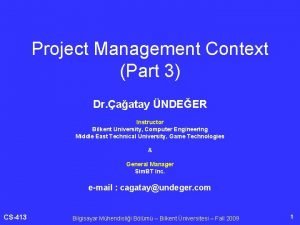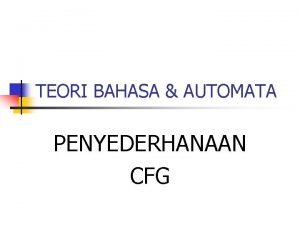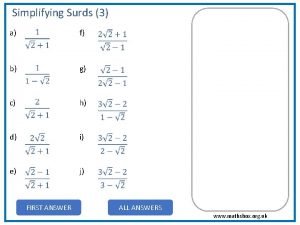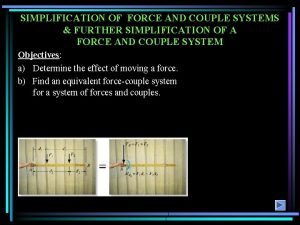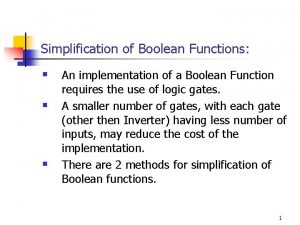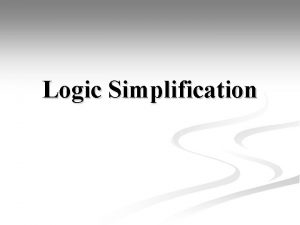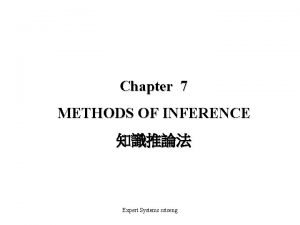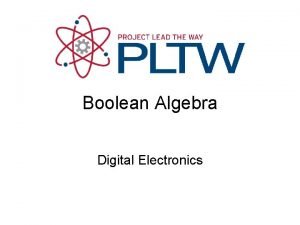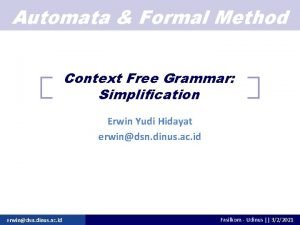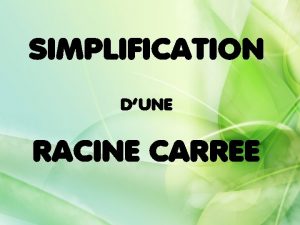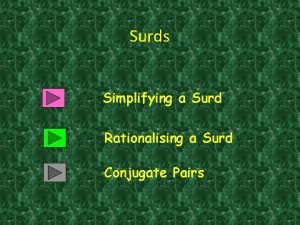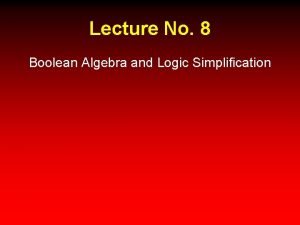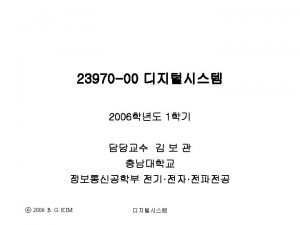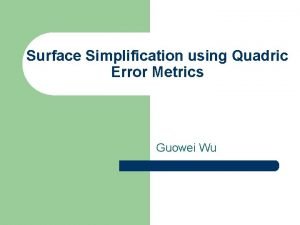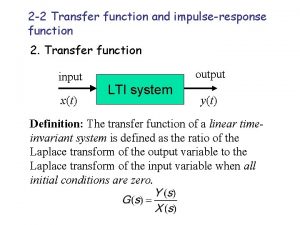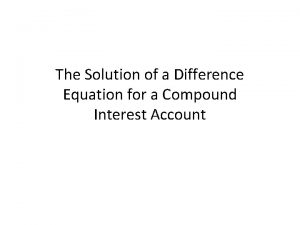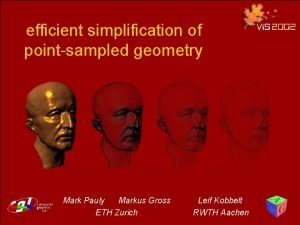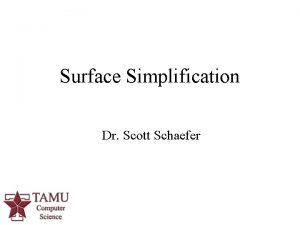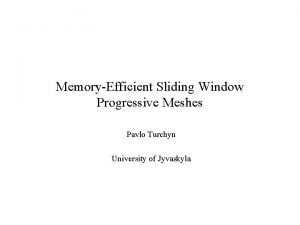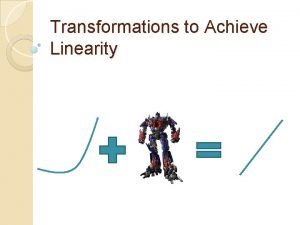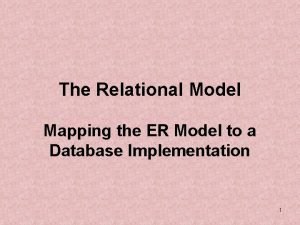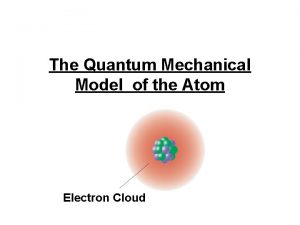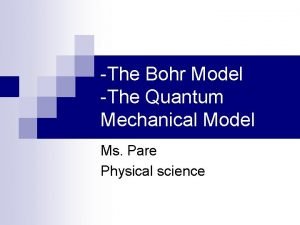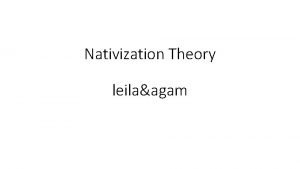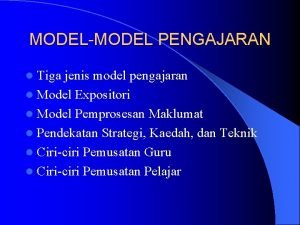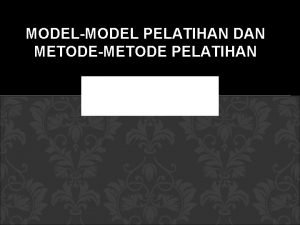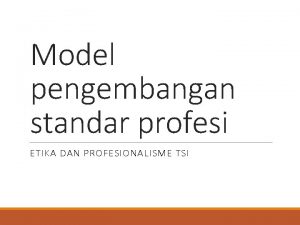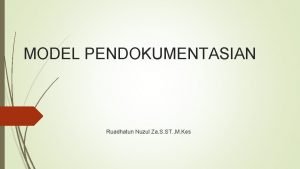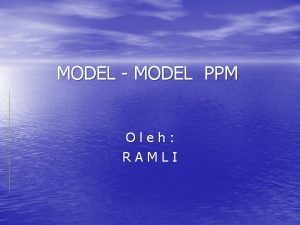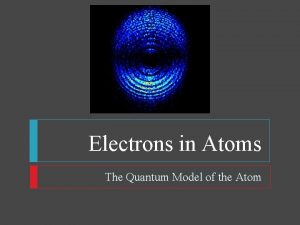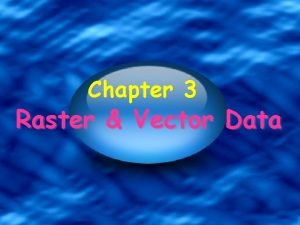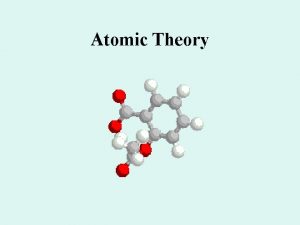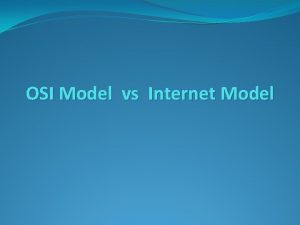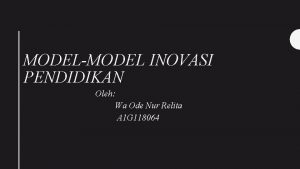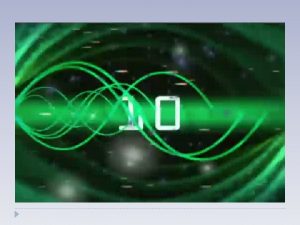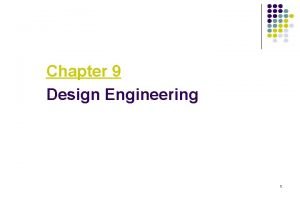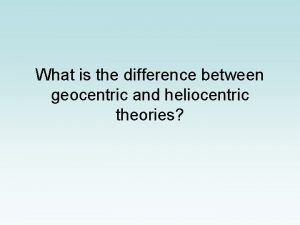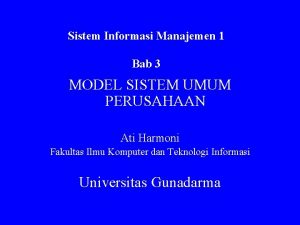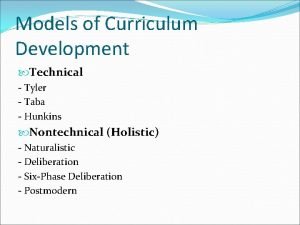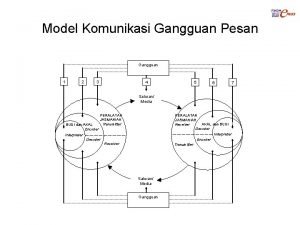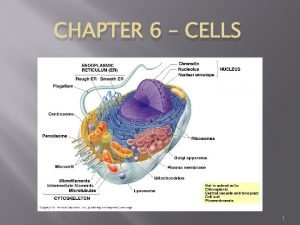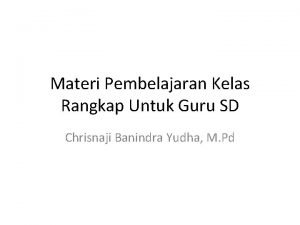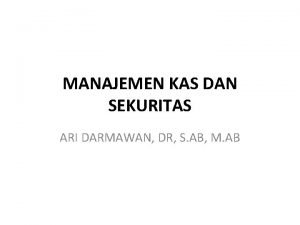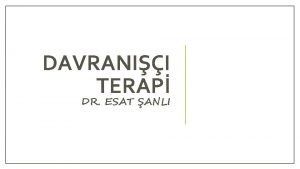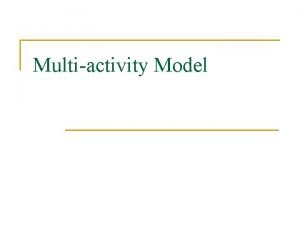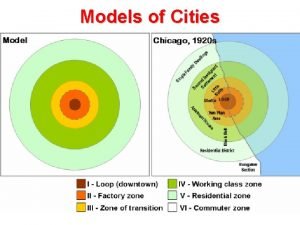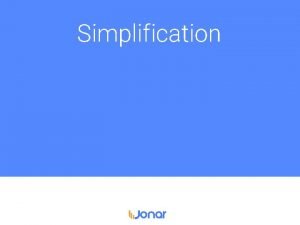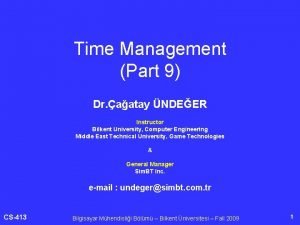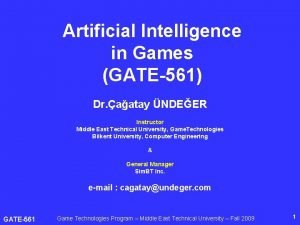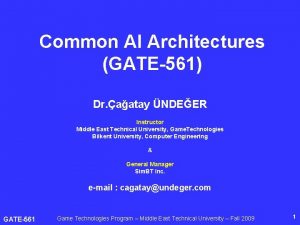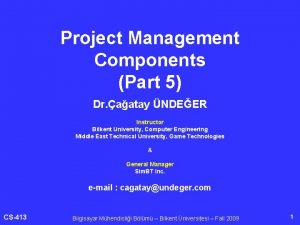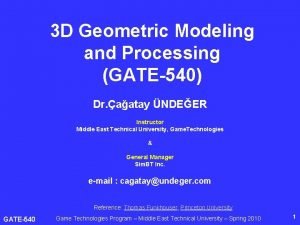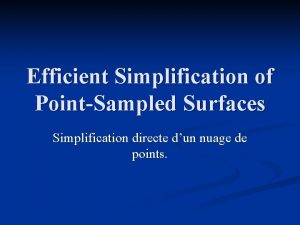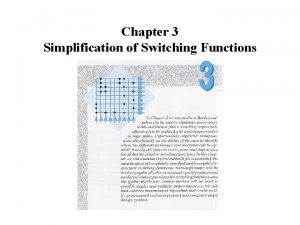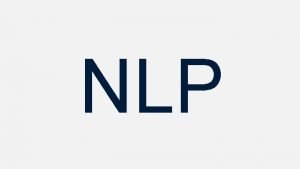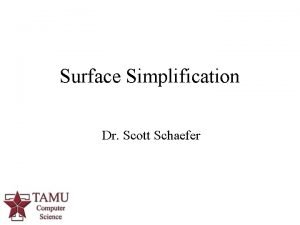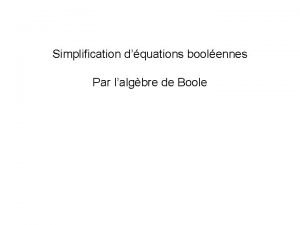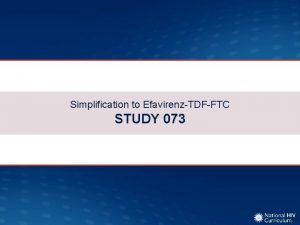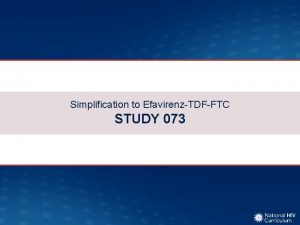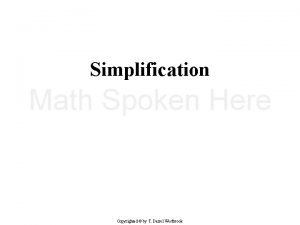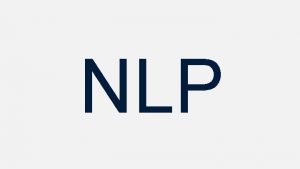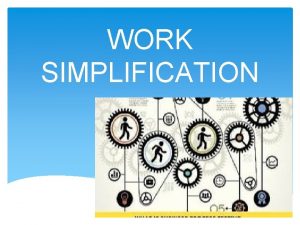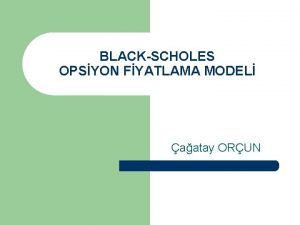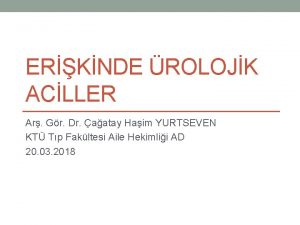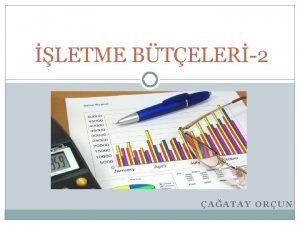3 D Model Simplification GATE540 Dr aatay NDEER








































































- Slides: 72

3 D Model Simplification (GATE-540) Dr. Çağatay ÜNDEĞER Instructor Middle East Technical University, Game. Technologies & General Manager Sim. BT Inc. e-mail : cagatay@undeger. com References: David P. Luebke, A Developer’s Survey of Polygonal Simplification Algorithms Mark Duchaineau et al. ROAMing Terrain: Real-Time Optimally Adapting Meshes GATE-540 Game Technologies Program – Middle East Technical University – Spring 2010 1

Outline • • GATE-540 Introduction to Simplification Algorithm Selection Criteria Kinds of Simplification Algorithms Brief Description of Simplification Algorithms 2

Polygonal Models • Currently dominate interactive computer graphics because of – Their mathematical simplicity and – Their simple, regular rendering algorithms that embed well in hardware. GATE-540 3

Difficulties of Polygonal Models • Complexity of polygonal models are measured by the number of polygons • Complexity of required models seems to grow faster than the ability of our graphics hardware to render them interactively. GATE-540 4

Polygonal Simplification • Offers one solution for developers to deal with these complex models. GATE-540 5

Polygonal Simplification • Flight simulators have long used hand-crafted multi-resolution airplane models to guarantee a constant frame rate. • In this course, we will deal with automated simplification of these models. GATE-540 6

Determining Appropriate Algorithm • Need to answer several questions: – Why do I need to simplify models? – What do my models seem like? – What is important to me the most? GATE-540 7

Why do I Need to Simplify? • Trying to eliminate redundant geometry? – e. g. Volumetric iso-surfaces generated by the marching cubes algorithm tile the model’s flat regions with many small, coplanar triangles? – After subdivision of a model for finiteelement analysis, a simplification algorithm is required to remove unnecessary geometry? GATE-540 8

Why do I Need to Simplify? • Trying to reduce model size? – Geometric compression? – Creating a downloadable models for a Web site? – Minimizing storage requirements? GATE-540 9

Why do I Need to Simplify? • Trying to improve runtime performance? – Generating levels of detail (LODs) of the objects in a scene? – Simplifying the polygonal scene being rendered, • By representing distant objects with a lower LOD and nearby objects with a higher LOD? GATE-540 10

What do My Models Seem Like? • No algorithm today exists that simplifying all models sucessully. • Organic forms with smooth curves. • Mechanical objects with sharp corners, flat faces, and regular curves. • Precomputed colors, lighting or texture that must be considered. GATE-540 11

What do My Models Seem Like? • A few large, high-complexity, individual objects (e. g. terrain data, medical data). • Multiple objects of moderate complexity. • Large assemblies of many small objects. GATE-540 12

What is Important to Me? • Preserve accuracy in the simplified models? – Control the Hausdorff distance of the simplified vertices / surface to the original – Bound the volumetric deviation of the simplified mesh from the original. . . • Just want high visual fidelity? – Perception is more difficult to quantify than geometry • Preserve model’s topological genus? GATE-540 13

What is Important to Me? • If run-time performance is crucial, – You may need an algorithm capable of drastic simplification. • A drastic simplification may require: – View-depended simplification – Topology-reduction simplification GATE-540 14

Kinds of Algorithms • Many approaches, each with strengths and weaknesses. – Treatment of mesh topology – Simplification mechanism – Static, dynamic, view-depended GATE-540 15

Treatment of Mesh Topology • Provides an important distinction • Topology: connected polygonal mesh structure • Genus: number of holes in the mesh surface Genus of zero Genus of one GATE-540 Genus of three 16

Treatment of Mesh Topology • The mesh forms a 2 D manifold – if the neighborhood of every feature consists of a connected ring of polygons forming a single surface. • In a triangulated manifold mesh: – Exactly two triangles share every edge, and – Every triangle shares an edge with exactly three neighboring triangles. (accept borders) GATE-540 17

Treatment of Mesh Topology • Manifold meshes result in well-behaved models. • Any simplification algorithm can successfully operate on any manifold object. • Some algorithms (e. g. marching-cubes) guarantee manifold output. • Some models have cracks, T-junctions, and nonmanifold points or edges. GATE-540 18

Treatment of Mesh Topology • A topology-preserving simplification algorithm: – Preserves manifold connectivity at every step. – Fidelity tends to be relatively good. – Can’t be simplified drastically. – Requires a mesh with manifold topology. • A topology tolerant simplification algorithm: – Ignores regions in the mesh with nonmanifold local topology, – Leaves those regions unsimplified. GATE-540 19

Treatment of Mesh Topology • A topology-modifying algorithm: – Don’t necessarily preserve manifold topology. – May close up holes in the model and aggregate separate objects into assemblies – Permitting drastic simplification beyond the scope of topology-preserving schemes. – Often provides poor visual fidelity. – Good at real-time visualization of complex scenes. GATE-540 20

Simplification Mechanism • Four basic polygon removal mechanisms: – Sampling, – Adaptive subdivision, – Decimation, and – Vertex merging. GATE-540 21

Sampling • Sample the initial model’s geometry: – With points on the model’s surface or – With voxels superimposed on the model in a 3 D grid. • More elaborate and difficult to code approaches. • Trouble achieving high fidelity. • Work best on smooth organic forms with no sharp corners. GATE-540 22

Adaptive Subdivision • Finds a simple base mesh that can be recursively subdivided to closely approximate the initial model. • Requires creating a base model that captures the original model’s important features, which can be tricky. • Preserve the surface topology, which may limit their capacity for drastic simplification. GATE-540 23

Decimation • Iteratively remove vertices or faces from the mesh, re-triangulating the resulting hole after each step. • Relatively simple to code and can be very fast. • Use strictly local changes that tend to preserve the genus. • This restricts drastic simplification. GATE-540 24

Vertex Merge • Collapses two or more vertices of a triangulated model into a single vertex, – Which in turn can be merged with other vertices. GATE-540 25

Vertex Merge • A simple and easy-to-code mechanism. • Range from simple, fast, and crude to complex, slow, and accurate. GATE-540 26

Static, Dynamic, and View. Dependent Simplification • Traditional static approach: – Polygonal simplification creates several discrete versions of each object in a preprocess, each at a different LOD. – Decoupling simplification and rendering makes this the simplest model to code. – Each LOD can be converted during preprocessing to triangle strips and compiled as a separate display list. GATE-540 27

Static, Dynamic, and View. Dependent Simplification • Dynamic approach: – Creates a data structure, which encodes a continuous spectrum of detail. – Desired LOD can be extracted from this structure at run-time. – Advantage: uses no more polygons than necessary. GATE-540 28

Static, Dynamic, and View. Dependent Simplification • View-dependent simplification: – Extends dynamic simplification by using viewdependent criteria – Selects the most appropriate LOD for the current view. GATE-540 29

Brief Description of Some Simplification Algorithms • • • GATE-540 Triangle Mesh Decimation Vertex Clustering Multiresolution Analysis of Arbitrary Meshes Voxel-Based Object Simplification Envelopes Appearance-Preserving Simplification Quadric-Error Metrics Image-Driven Simplification Progressive Meshes Real-Time Optimally Adapting Meshes (ROAM) 30

Triangle Mesh Decimation • By Schroeder, Zarge, and Lorenson • Simplify general polygonal models. • Term decimation for iterative removal of vertices. • Designed to operate on the output of the marching cubes algorithm. • Coplanar regions divided into many more polygons than necessary. GATE-540 31

Triangle Mesh Decimation • Multiple passes over all the vertices: – If the vertex can be removed without violating the local topology, and – If resulting surface would lie within a user-specified distance of the unsimplified geometry, – Deletes vertex and all its associated triangles. – Hole in the mesh is re-triangulated. GATE-540 32

Triangle Mesh Decimation • Vertices of simplified model are a subset of the original model’s vertices. • Convenient for reusing normals and texture coordinates at the vertices. • Limit the fidelity of the simplifications. • Quite fast and topology tolerant. • Available as part of the Visualization Tool Kit at http: //www. kitware. com/vtk. html GATE-540 33

Vertex Clustering • By Rossignac and Borrel • Topology insensitive, neither requiring nor preserving valid topology. GATE-540 34

Vertex Clustering • Assigns an importance to each vertex. • More Important: – Vertices attached to large faces and vertices of high curvature • Less Important: – Vertices attached to small faces and vertices of low curvature. GATE-540 35

Vertex Clustering • Overlays a 3 D grid on the model • Collapses all vertices within each cell of the grid to the single most important vertex in cell. GATE-540 36

Vertex Clustering • Grid’s resolution determines quality of simplification. • During the clustering process, – Triangles whose corners are collapsed together become degenerate and disappear. GATE-540 37

Vertex Clustering • A unique feature in rendering merged corners. • Renders using the graphics hardware line and point primitives. – a triangle with two corners collapsed is a line – a triangle with three corners collapsed is a point GATE-540 38

Vertex Clustering • A different clustering approach called floatingcell clustering by Low and Tan. • Ranks vertices by importance. • A cell of user-specified size is centered on the most important vertex. • Collapses all vertices falling within the cell to the representative vertex. • The most important remaining vertex becomes the center of the next cell, • And the process repeats. GATE-540 39

Vertex Clustering • Extremely fast. • Run in O(n) time for n vertices. • Since algorithm: – Don’t preserve topology, and – Don’t guarantee the amount of error introduced by the simplified surface, Often less pleasing visually than those of slower algorithms. GATE-540 40

Multiresolution Analysis of Arbitrary Meshes (MRA) • Adaptive subdivision algorithm by Eck et al. • Uses a compact wavelet representation to guide a recursive subdivision process. • Fast enough to do at runtime • Guarantee that the simplified surface lies within a userspecified distance of the original model. GATE-540 Wavelet series is a squre-integrable function. 41

Multiresolution Analysis of Arbitrary Meshes (MRA) • Provides a method for finding a simple base mesh – That exhibits subdivision connectivity, – So that recursive subdivision will recover the original mesh. GATE-540 42

Multiresolution Analysis of Arbitrary Meshes (MRA) • Base mesh by growing Voronoi-like regions across the original surface’s triangles. • When these regions can’t grow anymore, – Voronoi sites form a Delaunay-like triangulation, and – The triangulation forms the base mesh. GATE-540 43

Multiresolution Analysis of Arbitrary Meshes (MRA) • Manifold topology is required in the input model. • Strict topology-preserving approach. • Original object’s shape and genus limit the potential for drastic simplification. • Fidelity is quite high for smooth, organic forms. • Has difficulty capturing sharp features. GATE-540 44

Voxel-based Object Simplification • By He et al. • Simplify topology in a gradual and controlled manner using a signal processing approach. • Sample a volumetric representation of the model • By Superimposing a 3 D grid of voxels over the polygonal geometry. GATE-540 45

Voxel-based Object Simplification • Aassigns each voxel a value of 1 or 0, – According to whether the sample point of that voxel lies inside or outside the object. • Resamples the volume with a lower resolution – To elliminate small, high-frequency features. • Applies marching cubes. • Uses topology-preserving algorithm as a postprocess to eliminate redundant geometry. GATE-540 46

Voxel-based Object Simplification • High-frequency details such as sharp edges and corners are lost. – Greatly restricts its usefulness on mechanical CAD models. • Isn’t topology tolerant, – Since deciding whether sample points lie inside or outside the object requires closedmesh objects. GATE-540 47

Simplification Envelopes • By Cohen et al. • Guarantee fidelity bounds – While enforcing global and local topology. • Two offset surfaces, no more than some distance ε from the original surface. ε -ε GATE-540 outher original inner 48

Simplification Envelopes • Outher envelope – Displaces each vertex of the original mesh along its normal by ε, • Inner envelope: – Displaces each vertex by −ε. • Aren’t allowed to self-intersect. – If so, algorithm decreases ε in the local neighborhood. GATE-540 49

Simplification Envelopes • Envelopes can guide the simplification process. • Keeping simplified surface within envelopes • Iteratively remove triangles or vertices, and • Retriangulate the resulting holes. GATE-540 50

Simplification Envelopes • Surface never deviates by more than ε from the original model. • Resulting simplifications tend to have excellent fidelity. • Strict preservation of topology • Not good for drastic simplification. • Requires an orientable manifold. • implementation at http: //www. cs. unc. edu/~geom/envelope. html. GATE-540 51

Appearance-Preserving Simplification • By Cohen, Olano, and Manocha • Takes the error-bounding approach of simplification envelopes a step further. • Provides the best guarantees on fidelity of any simplification algorithm. GATE-540 52

Appearance-Preserving Simplification • Fidelity is expressed in terms of maximum screenspace deviation. • Rendered image deviate from the original’s appearance by no more than a user-specified number of pixels. GATE-540 53

Appearance-Preserving Simplification • Attributes affecting appearance: – Surface position: the coordinates of the vertices. – Surface color: the color field across the mesh. – Surface curvature: Field of normal vectors across the mesh. GATE-540 54

Appearance-Preserving Simplification • The simplification process uses edge collapses. • Edge collapses that cause surface color, normals, or position to shift by more than the maximum user-specified distance ε aren’t allowed. GATE-540 55

Appearance-Preserving Simplification GATE-540 56

Quadric Error Metrics • A vertex-merging algorithm by Garland Heckbert • Perhaps has the best balance yet between speed, fidelity, and robustness. GATE-540 57

Quadric Error Metrics • Iteratively merging pairs of vertices ( which may not need be connected by an edge). • Candidate vertex pairs include: – All vertex pairs connected by an edge, – Plus all vertex pairs separated by less than a user-specified distance threshold t. GATE-540 58

Quadric Error Metrics • All candidate vertex pairs are sorted into a priority queue according to the quadric error metric calculated for merging them. • Removes vertex pair with the lowest merge error from the top of the queue and merges it. • Updates the errors of all vertex pairs involving the merged vertices and • Repeats the process. GATE-540 59

Quadric Error Metrics • A simple way to guide the simplification process. • Extremely fast. • Relatively minor storage costs. • Visual fidelity tends to be quite high. • Doesn’t require manifold topology. • Lets holes close and objects merge. • QSlim, available at http: //graphics. uiuc. edu/~garland/software/ qslim. html GATE-540 60

Image-Driven Simplification • By Lindstrom and Turk • First to address simplification directly in terms of how the simplified model will look when rendered. • Occurs through a sequence of edge collapse operations using a priority queue. • Uses a purely image-based metric. GATE-540 61

Image-Driven Simplification • Determines the cost of an edge collapse operation by; – Performing the collapse and – Rendering the model from multiple viewpoints. – Comparing rendered images to images of the original model and – Sums up the mean-square error in luminance across all pixels of all images. GATE-540 62

Image-Driven Simplification • Lindstrom and Turk used 20 viewpoints in their implementation. • Rendering the entire model for every edge and from many viewpoints is clearly an expensive step. • Optimization: – Edge collapse affects only a small region of the screen. – Only a small portion of the triangles need be rendered per image. GATE-540 63

Progressive Meshes • Represents polygonal models as a sequence of edge collapses. • First dynamic simplification algorithm for general polygonal manifolds. • Later extended them to support viewdependent simplification. GATE-540 64

Progressive Meshes • Consists of a simple base mesh created by: – A sequence of edge collapse operations – A series of vertex split operations. • A vertex split is the dual of an edge collapse. GATE-540 65

Progressive Meshes • Each vertex split: – Replaces a vertex by two edge-connected vertices, – Creating one additional vertex and two additional triangles. • Correspond to the dual of edge-collapse operations used to create the base mesh. • This will recapture the original model exactly. • Fast enough to perform in real-time. GATE-540 66

Progressive Meshes • Models mesh complexity and fidelity as an energy function to be minimized. • Sorts edges into a priority queue. • Energy function is minimized in a greedy fashion by performing edge collapse operations at the head of the queue. • Sequence of edge collapse operations performed becomes the hierarchy of vertex split operations. GATE-540 67

Progressive Meshes • 3 view-dependent simplification criteria: – A view frustum test – A backfacing test – A screenspace error threshold GATE-540 68

Progressive Meshes • Manifold topology is required. • Prevents holes from closing and objects from aggregating. • Hoppe’s energy-minimization approach – Produces high-fidelity simplifications – But is relatively slow. • Instead, any algorithm based on edge collapses can be used to generate a progressive mesh. GATE-540 69

Real-Time Optimaly Adapting Meshes (ROAM) • By Mark Duchaineau et al. • A view-dependent simplification algorithm. • Dynamic terrain and simple vertex morphing. GATE-540 70

Real-Time Optimaly Adapting Meshes (ROAM) • Uses: – A bintree. – 2 priority queues to drive triangle split and merge. GATE-540 71

Real-Time Optimaly Adapting Meshes (ROAM) • Originally developed for flight simulators. • Provides high quality triangulations at high frame rates. GATE-540 72
 Aatay
Aatay Cfg automata
Cfg automata Simplify a surd
Simplify a surd Force-couple system examples
Force-couple system examples Boolean function simplification
Boolean function simplification Simplification propaganda
Simplification propaganda Logic simplification using boolean algebra
Logic simplification using boolean algebra Bandwagon effect ads
Bandwagon effect ads Panalogy
Panalogy Rule of conjunctive simplification
Rule of conjunctive simplification Consensus theorem in digital electronics
Consensus theorem in digital electronics How to simplify context free grammar
How to simplify context free grammar Simplifier racine carré
Simplifier racine carré Examples of conjugate surds
Examples of conjugate surds Simplification asdw
Simplification asdw Boolean algebra simplification
Boolean algebra simplification Splash graphic novel definition
Splash graphic novel definition Binary logic diagram
Binary logic diagram Guowei wu
Guowei wu Block diagram simplification examples
Block diagram simplification examples Simplification formulas
Simplification formulas Efficient simplification of point-sampled surfaces
Efficient simplification of point-sampled surfaces Simplification
Simplification Simplification
Simplification Difference between concentric zone model and sector model
Difference between concentric zone model and sector model Strength of taba model
Strength of taba model Transforming to achieve linearity
Transforming to achieve linearity Mapping of er model to relational model
Mapping of er model to relational model Quantum mechanical model
Quantum mechanical model Niels bohr quantum mechanical model
Niels bohr quantum mechanical model Nativization definition
Nativization definition Teori teori motivasi
Teori teori motivasi Model-model pengajaran
Model-model pengajaran Model-model pelatihan
Model-model pelatihan 13 model perilaku konsumen
13 model perilaku konsumen Model model etika profesi
Model model etika profesi Model pendokumentasian komputer
Model pendokumentasian komputer Model model ppm
Model model ppm Cobweb model international relations
Cobweb model international relations Compare and contrast bohr model to quantum model
Compare and contrast bohr model to quantum model Raster model vs vector model
Raster model vs vector model Bohr rutherford diagram
Bohr rutherford diagram Bohr model vs quantum model venn diagram
Bohr model vs quantum model venn diagram Geocentric model vs heliocentric model
Geocentric model vs heliocentric model Osi model vs internet model
Osi model vs internet model Model-model inovasi pendidikan
Model-model inovasi pendidikan Contoh format flowsheet keperawatan
Contoh format flowsheet keperawatan Abcx
Abcx Soba model
Soba model Analysis model to design model
Analysis model to design model Geocentric and heliocentric similarities
Geocentric and heliocentric similarities Characteristics of polis
Characteristics of polis Model pengambilan keputusan
Model pengambilan keputusan Model informasi
Model informasi Model model perilaku abnormal
Model model perilaku abnormal Importance of organisational behaviour
Importance of organisational behaviour Advantages of tyler model
Advantages of tyler model Different models of communication
Different models of communication Model pengembangan kurikulum ralph tyler
Model pengembangan kurikulum ralph tyler Gangguan pesan
Gangguan pesan Perkembangan teori atom modern
Perkembangan teori atom modern Davson danielli model vs fluid mosaic model
Davson danielli model vs fluid mosaic model Davson danielli model vs fluid mosaic model
Davson danielli model vs fluid mosaic model Lean model canvas vs business model canvas
Lean model canvas vs business model canvas Limitations of linear model of communication
Limitations of linear model of communication Electron cloud model vs bohr model
Electron cloud model vs bohr model Contoh keserempakan kegiatan pembelajaran
Contoh keserempakan kegiatan pembelajaran Rumus model miller dan orr
Rumus model miller dan orr örtük model alma
örtük model alma Bookstore database design
Bookstore database design Cash management models ppt
Cash management models ppt Model model activity
Model model activity Concentric zone model zone of transition
Concentric zone model zone of transition
